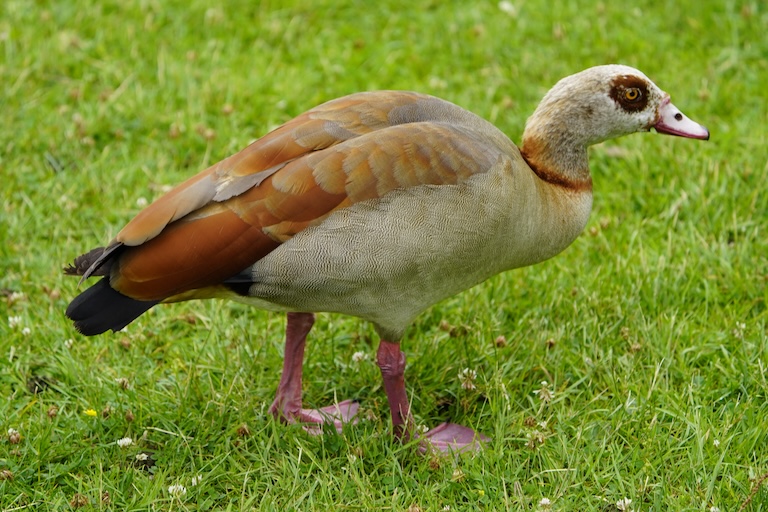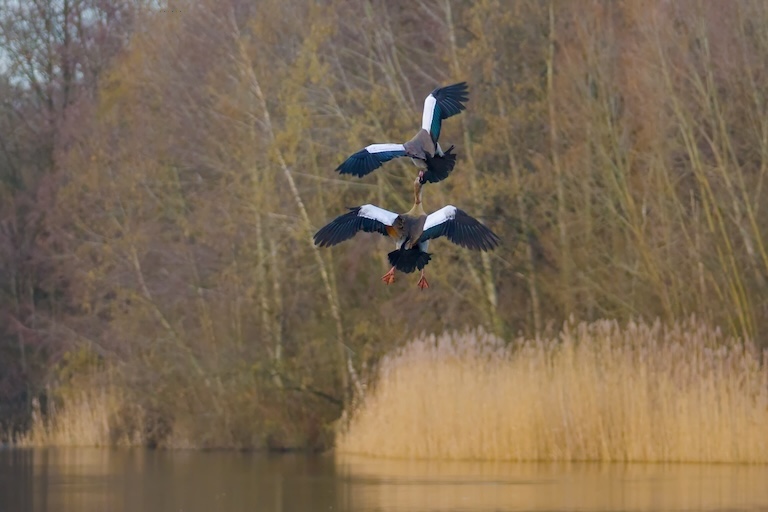Egyptian Goose Profile
If it looks like a duck, swims like a duck, and quacks like a duck, then it probably is a duck. But what if it also perches like a songbird and honks like a goose, and eats all your crops and fills your ponds with poo? This is what taxonomists are struggling over with the Egyptian goose.

Egyptian Goose Facts Overview
| Habitat: | Open or semi-open habitats, typically near fresh water |
| Location: | Native to Africa, introduced worldwide |
| Lifespan: | 15 in the wild, 35 in captivity |
| Size: | 63–73 cm (25–29 in) tall |
| Weight: | Up to 2.3 kg 80 oz |
| Colour: | Variable: dark grey and rusty brown on the body with blacks, whites and rusty wings, and a red eye ring. |
| Diet: | Young grass, grains, soft vegetation and detritus |
| Predators: | Leopards, lions, hyenas, cheetahs, raptors, crocodiles |
| Top Speed: | Possibly up to 80 km/h (50 mph) |
| No. of Species: | 1 |
| Conservation Status: | Least Concern |
The Egyptian goose is a weird one for a number of reasons. This heavy, duck-looking thing is not really a goose – though it honks aggressively like one, and it’s not quite a duck, either. And unlike most of these, it has been known to perch on a branch.
This quirky bird has made its way out of its native Africa and spread almost everywhere, and while it’s fun to look at, some of the natives aren’t as happy to have it around.
Interesting Egyptian Goose Facts
1. They’re half goose, half duck
The family Anatidae is home to all the geese, ducks and swans, and they’re separated generally at the subfamily level.
The majority of the animals we call ducks are members of the Anatinae subfamily and the majority of geese are in the Anserinae subfamily. There are lots of other convolutions, and the taxonomy isn’t settled yet, but this is the general state of things so far.
Somewhere between these two subfamilies, at least superficially, is the Tadorninae family, or the Shelducks and Sheldgeese. These are animals who resemble a bit of both and are typically smaller than geese but much more noisy and jerkish than ducks.
Still, so-called shelducks and sheldgeese are separated at the genus level, and the Egyptian goose isn’t one of these, either. It’s the only member of its genus, thought to be most closely related to the shelduck genus Tadorna.
However, this isolation may not last forever, as there’s some suggestion the relatedness of these two genera might be closer than is currently accepted. As always, it’s a truly gripping time to be alive in the world of animal taxonomy.

2. The males and females look alike
Even within genera among the shelducks and sheldgeese, there seems to be no pattern in sexual dimorphism. That is, some species have different-looking males and females and others don’t.
Egyptian geese don’t. They make it very difficult to tell the sexes apart, though males are a bit bigger than females.
They vary quite a lot in colour and patterns, too, and some are more grey while others are more brown. 1
3. They honk and quack
True to their name, these are honky birds, but they are also quacky ones. Vocalisations are one way to tell the males from the females, as the male’s quiet duck-like quack is contrasted by the female’s far nosier one, but both exhibit goosy behaviours when mating, including loud honking, neck stretching and similar such hooliganism we have come to expect from their namesakes.
4. They perch
Spotting a pair of Egyptian geese perched high in the branches of an old sausage tree is an experience very similar to Lisa Simpson witnessing the hatching of a rhino’s egg.
But this is very much a real phenomenon, and one that isn’t commonly associated with ducks or geese.
There’s a seemingly unrelated group of birds known as “Perching ducks” and Egyptian geese are one of them, often spotted defiantly standing on branches instead of sitting in the water like they’re supposed to. 2
5. They stay in groups
Egyptian geese prefer large numbers, being much smaller than real geese, their empty threats are taken less seriously, so sticking together is a smart choice.
This species spends most of its time in flocks, and these can be quite large, more than big enough to affect the ecosystem around them on a large scale.
Habitat damage is common in areas where these birds aggregate in large numbers, often in the form of eutrophication, or toxic build-up in water bodies from the tremendous amount of what biologists refer to as “shit” that comes out of them all.
This can kill fish and create algal blooms, both of which can tip the balance of the local environment for a while.
The amount of damage caused by this is highly debatable, however, and there’s a strong incentive for farmers to exaggerate it in order to get government backing to start killing the birds. Like Canada geese, Egyptian geese are unpopular for their perceived impact on agricultural land. 3

6. They might be invasive
When a species is introduced to a new location if it’s not invasive, it eventually gets registered as “introduced” for a while, then perhaps “naturalised” or “established” and sometimes “wild non-native”, and this can continue for far too long as the people who write the books care to grumble on about what is essentially an ecological immigration issue.
Finally, someone with sense comes along and decides that we’re clearly never getting rid of it, so might as well accept it and adds the animal to the list of official native species.
That’s what happened in Britain with the Egyptian goose, having arrived in the 17th Century and been faced with xenophobia until as late as the 1970s when it was finally accepted on the list of British birds, or perhaps even in 2009 when it was officially declared an official non-native species.
Still, as a shifty-looking foreigner, it’s still not offered the same protections as native fauna and can be shot without permission by farmers who don’t like your kind around ‘ere.
In the US though, the species definitely is more destructive, and in Northern Europe, the jury is still out as to whether their arrival and subsequent expansion is going to cause notable harm.
So far it looks like the population expanded rapidly and has since slowed down, but how much their aggression plays a role in the ecosystem is yet to be determined.
7. They’re aggressive
Living up to the goose side of their name, this animal has no off button and will express every emotion it’s capable of through hissing and lunging at everything.
This is an attitude problem that a lot of the native fauna isn’t really expecting from a duck-shaped animal, and while they may know where they stand with the Canada goose, this smaller duck thing gives them the willies and they are often displaced from their homes.
And this isn’t limited to rival species; Egyptian geese are quite rude to one another too, especially when breeding, to the point where they are even known to kill their neighbours’ offspring – a common fantasy among the human population but (thankfully) not one that is as often carried out. 4

Egyptian Goose Fact-File Summary
Scientific Classification
| Kingdom: | Animalia |
| Phylum: | Chordata |
| Class: | Aves |
| Order: | Anseriformes |
| Family: | Anatidae |
| Genus: | Alopochen |
| Species: | aegyptiaca |
Fact Sources & References
- M Sraml (1996), “Molecular Relationships Within Australasian Waterfowl (Anseriformes)”, Australian Journal of Zoology.
- “Egyptian Goose”, Cornell Lab.
- Anna Tattan “Alopochen aegyptiaca Egyptian goose”, Animal Diversity Web.
- Abel Gyimesi “Egyptian Goose Alopochen aegyptiaca: an introduced species spreading in and from the Netherlands”, Wildfowl Journal.
